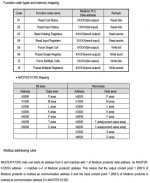wow... there really is so much to learn about modbus communication. I'm trying to connect PLC k120s with an inverter LS sv-ic5. I can operate the inverter from PC with DriveView, so I think the modbus connection is working, so I'm wondering if I could operate it with PLC, like change the parameter or etc. is it possible?
Yes. We use Micrologix 1400 PLCs to control LSIS H100 VFDs. We don't try to modify all parameters over the RS485 network, but will adjust speed, accel, decel and the command word and monitor 8 parameters from the VFD using read and write messages in the PLC.
You will need to program the VFD to allow the speed and command words to be derived from the Comm channel, and set the Comm parameters to match those in the PLC (baud, parity, stop bits). Each device needs a unique Modbus ID.
Look at the VFD parameters:
DRV 06 = 3 = "Command Source 3 = Communication port"
DRV 07 = 6 = "Frequency Source 6 = Communication port"
COM 01 = "Modbus ID"
COM 02 = 0 = "Modbus Protocol"
COM 03 = "Speed (4=19.2k)"
COM 04 = 0 = "Frame settings: 0 = 8 data bits, no parity, 1 stop bit"
COM 05 = "Response Delay ms (100 works well for us)"
COM 30 = "Output Parameter Count (we want to read 8 values, your application may be different)"
COM 31 = 000A = "First parameter to poll at Modbus address 40256 000A = Output Frequency"
COM 32 = 000E = "2nd parameter to poll at Modbus address 40257 000E = Operation Status Bits"
COM 33 = "3rd parameter to poll at Modbus address 40258"
COM 34 = "3rd parameter to poll at Modbus address 40259"
etc for more than four words to be read by your PLC.
COM 50 = "Input Parameter Count...words to be written by the PLC as inputs to the VFD"
COM 51 = 0005 = "0005 = Command Frequency"
COM 52 = 0006 = "0005 = Operation Command Bits"
etc if using more than 2 input parameters.
Also review parameters:
PRT 12 = "Speed Command Loss action...what happens if comms stop?"
PRT 13 = "Comm Timeout Seconds...how long until the drive executes the action in PRT 12"





